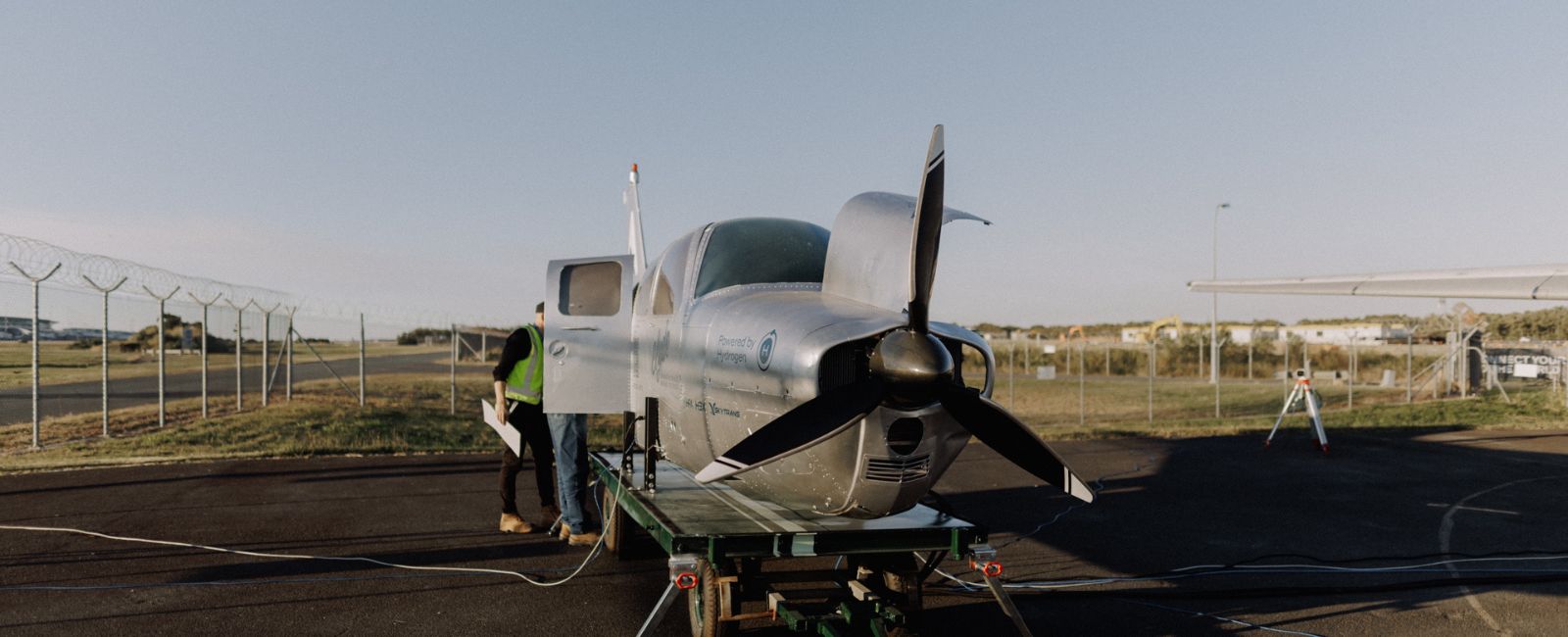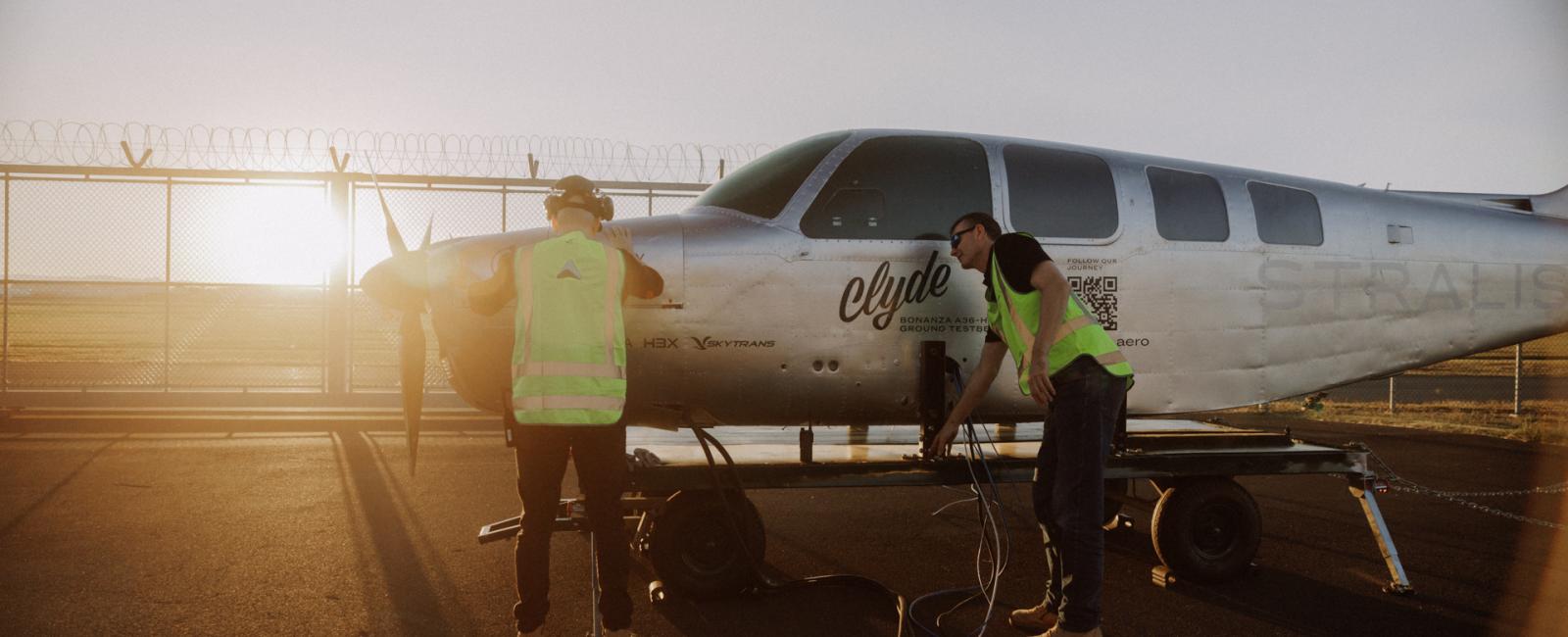
Since Brisbane Airport set its sustainability commitment, Scope 3 emissions have always been recognised as the biggest challenge. These emissions, largely from aviation fuel, make up 99% of the airport’s carbon footprint. Solving them requires new technology and strong partnerships, which is why Brisbane Airport has been working alongside local startup Stralis Aircraft and the Hydrogen Flight Alliance to advance technologies for zero-emission flights.
Stralis is developing hydrogen-electric propulsion systems that could change aviation as we know it. Their work begins with two six-seat Beechcraft Bonanza aircraft, affectionately named Bonnie and Clyde.
By starting small, the team can design, test and refine the technology before scaling it to larger aircraft. “Our long-term vision is to power large commercial planes,” explains Stralis Co-Founder and CEO Bob Criner. “But the revolution begins with Bonnie and Clyde. These testbeds allow us to move quickly and safely, proving the system step by step.”
Late in 2024, Clyde was the star of a milestone moment at Brisbane Airport – the first hydrogen-electric propeller spin on a registered aircraft in the southern hemisphere. The event was backed by months of preparation involving Brisbane Airport’s operations team, emergency services, Civil Aviation Safety Authority (CASA) and fire and safety teams. “It was a huge effort from everyone on site,” says Bob. “What looks like a simple test represents years of engineering and weeks of training to make sure it could happen safely.”
For Brisbane Airport, moments like this show strong progress in the industry’s efforts to reduce aviation emissions. Jessica King, Head of Sustainability at Brisbane Airport, says they are invested in new technology so they can plan and prepare for what comes next. “Over 40% of our passenger flights from the Domestic Terminal travel 800km or less. This technology has the potential to reduce emissions of these flights,” she says.
“That is a huge opportunity for Brisbane and I think what makes it possible is our team’s culture and our leadership team’s openness to innovation.”
The Hydrogen Flight Alliance, launched at Aviation Australia, Brisbane Airport in 2023, is central to this work. With more than a dozen members spanning the energy, infrastructure and aviation sectors, the alliance is building the ecosystem required for hydrogen flight.
Stralis’ Head of Partnerships, Dr Emma Whittlesea explains, “Hydrogen isn’t a new fuel – it’s already powering trucks, cars and mining equipment in Australia. What’s new is using it in aircraft here, and the alliance is helping to make that a reality and brings the whole ecosystem together, including airports, airlines, universities, and the hydrogen supply chain.”
Stralis acknowledges that the progress they are making has been helped by the support of Brisbane Airport. The spin test on Clyde at Aviation Australia was accompanied by site tours and workshops for Brisbane Airport employees, ensuring they were comfortable with how hydrogen is transported and stored. “It wasn’t just about one moment,” Jessica says. “It was about showing our people and our partners that we can handle this technology, and that we’ll be ready when it scales.”
The next step is first flight. Bonnie, Stralis’ airworthy Bonanza A36 aircraft, is being prepared for taxi tests and aims to take to the skies in the next 6 months. From there, the company plans a demonstration route between Brisbane and Gladstone.

For Bob, these ambitions are matched by a desire to build Australia’s reputation as an aircraft manufacturer. “We don’t build planes in Australia right now, but we used to,” he says. “This shift to cleaner propulsion opens a door for new players, and we want to make sure that opportunity is realised here in Brisbane.”
For Brisbane Airport, Jess says. “The future of decarbonising aviation depends on options like hydrogen. Our role is to support innovation, make our precinct attractive to new technology and ensure we are ready when it scales.”
With the Brisbane 2032 Olympic and Paralympic Games on the horizon, Stralis hopes to have certified hydrogen-electric aircraft flying athletes and spectators by then, providing a homegrown showcase of what sustainable aviation can look like. “It would be a proud moment to have planes built in Brisbane flying visitors to the Games,” Bob says.
As Bonnie edges closer to first flight, Brisbane Airport and Stralis are proving that the path to zero-emission aviation is being developed right here in Queensland, through persistence, partnership and a shared belief that the future of flight can be clean.

